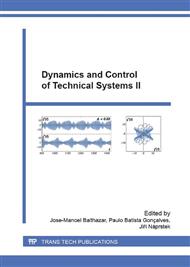[1]
J. M. T. Thompson and G. W. Hunt, Elastic instability phenomena, Great Britain: John Wiley and Sons, London, (1984).
Google Scholar
[2]
Z. Bazant and L. Cedolin, Stability of structures: elastic, inelastic, fracture and damage theories, Oxford University Press, Oxford, (1991).
Google Scholar
[3]
M. S. Soliman and P. B. Gonçalves, Chaotic behavior resulting in transient and steady state instabilities of pressure-loaded shallow spherical shells, Journal of Sound and Vibration. 259 (3) (2003) 497-512.
DOI: 10.1006/jsvi.2002.5163
Google Scholar
[4]
M. A. Savi, and J. B. Nogueira, Nonlinear dynamics and chaos in a pseudoelastic two-bar truss, Smart Materials and Structures. 19 (11) (2010) 1-11.
DOI: 10.1088/0964-1726/19/11/115022
Google Scholar
[5]
M. Greco, and W. S. Venturin, Stability analysis of three-dimensional trusses, Latin American Journal of Solids and Structures. 3 (3) (2006) 325-344.
Google Scholar
[6]
L. Kwasniewski, Complete equilibrium paths for Mises trusses, International Journal of Non-Linear Mechanics. 44 (1) (2009) 19-26.
DOI: 10.1016/j.ijnonlinmec.2008.08.011
Google Scholar
[7]
M. A. Crisfield, Non-linear finite element analysis of solids and structures: Advanced topics, John Wiley & Sons, (1997).
Google Scholar
[8]
S. S. Ligarò and P. S. Valvo, Large displacement analysis of elastic pyramidal trusses, International Journal of Solids and Structures. 43 (16) (2006) 4867-4887.
DOI: 10.1016/j.ijsolstr.2005.06.100
Google Scholar
[9]
M. P. Saka, Optimum geometry design of geodesic domes using harmony search algorithm, Advances in Structural Engineering. 10 (6) (2007) 595-606.
DOI: 10.1260/136943307783571445
Google Scholar
[10]
I. Ario, and A. Watson, Dynamic folding analysis for multi-folding structures under impact loading, Journal of Sound and Vibration. 308 (3) (2007) 591-598.
DOI: 10.1016/j.jsv.2007.03.078
Google Scholar
[11]
H. Kroto, C60, fullerenes, giant fullerenes and soot, Pure and Applied Chemistry. 62 (3) (1990) 407-415.
DOI: 10.1351/pac199062030407
Google Scholar
[12]
R. B. Ansems and L. T. Scott, Circumtrindene: A geodesic dome of molecular dimensions. Rational synthesis of 60 of C601, Journal of the American Chemical Society. 122 (12) (2000) 2719-2724.
DOI: 10.1021/ja993028n
Google Scholar
[13]
D. A. Pecknold, J. Ghaboussi and T. J. Healey, Snap-through and bifurcation in a simple structure, Journal of Engineering Mechanics. 111 (7) (1985) 909-922.
DOI: 10.1061/(asce)0733-9399(1985)111:7(909)
Google Scholar
[14]
A. López, I. Puente and M. A. Serna, Numerical model and experimental tests on single-layer latticed domes with semi-rigid joints, Computers & Structures. 85 (2007) 360-374.
DOI: 10.1016/j.compstruc.2006.11.025
Google Scholar
[15]
T. Schiøler and S. Pellegrino, Space frames with multiple stable configurations, AIAA Journal. 45 (2007) 1740-1747.
DOI: 10.2514/1.16825
Google Scholar
[16]
G.A. Hrinda, Snap-through instability patterns in truss structures, NASA Langley Research Center, Hamptom, Virginia, 2010, 23831.
Google Scholar
[17]
F. Fan, Z. Cao and S. Shen, Elasto-plastic stability of single-layer reticulated shells, Thin-Walled Structures. 48 (2010) 827-836.
DOI: 10.1016/j.tws.2010.04.004
Google Scholar
[18]
H. Saffari, N. M. Mirzai, I. Mansouri and M. H. Bagheripour, Efficient numerical method in second-order inelastic analysis of space trusses, Journal of Computing in Civil Engineering. 27 (2012) 129-138.
DOI: 10.1061/(asce)cp.1943-5487.0000193
Google Scholar
[19]
S. D. Shon, S. J. Lee and K. G. Lee, Characteristics of bifurcation and buckling load of space truss in consideration of initial imperfection and load mode, Journal of Zhejiang. 14 (2013) 206-218.
DOI: 10.1631/jzus.a1200114
Google Scholar
[20]
S. Lenci and G. Rega, A procedure for reducing the chaotic response region in an impact mechanical system, Nonlinear Dynamics. 15 (4) (1998) 391-409.
Google Scholar
[21]
G. Rega and S. Lenci, Recent advances in control of complex dynamics in mechanical and structural systems, in M.A.F. Sanjuan, C. Grebogi (Eds. ), Recent progress in controlling chaos, Series on Stability Vibration and Control of Systems. 16 (2009).
DOI: 10.1142/9789814291705_0007
Google Scholar
[22]
S. Lenci, D. Orlando, G. Rega, P. B. Gonçalves, Controlling practical stability and safety of mechanical systems by exploiting chaos properties, Chaos. 22 (2012) 047502 (15 pages).
DOI: 10.1063/1.4746094
Google Scholar
[23]
S. Lenci and G. Rega, Optimal control of nonregular dynamics in a Duffing oscillator, Nonlinear Dynamics. 33 (2003) 71-86.
Google Scholar
[24]
S. Lenci and G. Rega, Optimal control of homoclinic bifurcation: Theoretical treatment and practical reduction of safe basin erosion in the Helmholtz oscillator, Journal of Vibration and Control. 9 (2003) 281-315.
DOI: 10.1177/107754603030753
Google Scholar
[25]
S. Lenci and G. Rega, Global optimal control and system-dependent solutions in the hardening Helmholtz-Duffing oscillator, Chaos, Solitons & Fractals. 21 (2004) 1031-1046.
DOI: 10.1016/s0960-0779(03)00387-4
Google Scholar
[26]
G. Rega and S. Lenci, Dynamical integrity and control of nonlinear mechanical oscillators, Journal of Vibration and Control. 14 (2008) 159-179.
DOI: 10.1177/1077546307079403
Google Scholar


